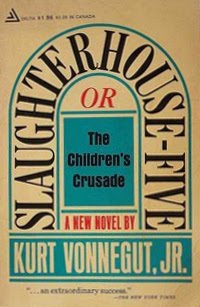“One thing was clear: Absolutely everybody in the city was supposed to be dead, regardless of what they were, and that anybody that moved in it represented a flaw in the design.” (113)

Having finished the book, I’m still not entirely sure what I was expecting when I picked up Slaughterhouse-5, Kurt Vonnegut‘s most well known work. Going in, all that I knew was that the book was about World War II, and that its protagonist was a pilgrim of sorts. Based off of this, I probably had only the most general of expectations; that it would be about war, and that it would have some spiritual aspect to it. However general these expectations may be, I cannot say that I was correct on either count. Slaughterhouse-5 reads more like a book of parables than anything else. It is broken up into many nonlinear subsections, some under a page in length. Each subsection tells its own small part of the story of protagonist Billy Pilgrim’s life, rarely in chronological order, and each weighed down with a profound sense of meaning. The end of almost every subsection left me staring blankly into nothingness, trying to decipher what was being said, and what was being meant.
The book follows the life of Billy Pilgrim, a physically weak, emotionally distant boy, who is drafted as a chaplain aid in WWII. In this regard it is a war story, but very little of the story is about the war itself, or even the plight in which the war places thousands of soldiers, Billy included. The book is better described as the story of Billy, who happens to have partially existed in the same time and space that the war existed in. Vonnegut considers the books to be his recount of the bombing of Dresden, but all in all very little attention is paid to the bombing itself, or even its aftermath. In a manner similar to Tim O’brien’s The Things They Carried, Slaughterhouse-5 effectively uses its writing style to communicate deep feelings of isolation, and the otherness of being a soldier. But unlike The Things They Carried, this is never fully in the spotlight. It is shown, but never spoken, and the books is far more flexible for it. Slaughterhouse-5 is the sort of book that if ten people read it, each will likely have a very different opinion on the book and what it meant. If those ten people are of a mind to contemplate what Vonnegut was trying to say, they, like I, will probably enjoy the book very much. Though its nonlinear nature is initially confusing, it is ultimately a self solving problem. Because the order matters so little, there is little to be confused about after the initial shock. Every subsection can mostly stand on its own, and the most it is likely to miss is a slight tie-in with another subsection.
Slaughterhouse-5 is a book best treated like a book of Confucian parables. It should be read slowly, and pondered at every break. Even if you lack the time or inclination to do so, it is worth reading purely because it uses interesting ideas about time and existence as fundamental backbone of its plot. The least that someone is likely to get out of this book is an interesting perspective of time and reality, and an unusually human painting of “children” at war. Slaughterhouse-5 is a short book, clocking in at 137 pages in my edition, and while it is certainly best experienced slowly and deliberately, it does not need to be. This is not a book that needs to take very much time. Between all of these observations, I would strongly recommend Slaughterhouse-5.
My only gripe about the books is rooted in its fundamental nature. Books written to communicate a sense of isolation are usually themselves very isolating to read, and Slaughterhouse-5 is no exception. This means that the experience of reading the book is not especially pleasant. This is not necessarily a flaw; not every books must or should be pleasant to read, and there are many books which ultimately benefit greatly for being miserable, depressing reads, or that would have failed to communicate properly if they where anything other than disturbing to read. That said, Slaughterhouse-5 makes less use of this than, for example, Art Spiegelman’s Maus, which to this day puts me in a deep funk every time I pick it up, even if I only skim a few pages.
One final note; if, as I recommend, you read this book, it is definitely worth reading a little bit about the bombing of Dresden somewhere along the way. There are a few pieces of the book which are objectively inaccurate regarding Dresden, and learning even a little bit about the city and the context of the bombing may be very helpful.
(807 words.)
As someone who absolutely loves Slaughterhouse Five and Vonnegut you have taken the words out of my mouth. Great job on summarizing a somewhat difficult and strange book. Im glad you enjoyed the book too, I think its one of those book everybody should pick up at some point in their lives. The way Vonnegut blends fiction with reality all while tackling such big concepts like time and death is incredible.
LikeLike
This book sounds really boring or just something I’m just not into.
LikeLike
I’ve definitely heard of this book, but I have never been big on old war books(WW1, WW2). The description makes it sound good, but I’m still a little skeptical about the writing style and how much of your enjoyment was simply interpretation.
LikeLike